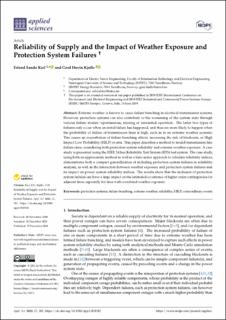| dc.contributor.author | Kiel, Erlend Sandø | |
| dc.contributor.author | Kjølle, Gerd Hovin | |
| dc.date.accessioned | 2021-02-08T14:36:47Z | |
| dc.date.available | 2021-02-08T14:36:47Z | |
| dc.date.created | 2020-12-28T15:36:54Z | |
| dc.date.issued | 2020 | |
| dc.identifier.citation | Applied Sciences. 2020, 11 (1), 1-15. | en_US |
| dc.identifier.issn | 2076-3417 | |
| dc.identifier.uri | https://hdl.handle.net/11250/2726668 | |
| dc.description.abstract | Extreme weather is known to cause failure bunching in electrical transmission systems. However, protection systems can also contribute to the worsening of the system state through various failure modes—spontaneous, missing or unwanted operation. The latter two types of failures only occur when an initial failure has happened, and thus are more likely to happen when the probability of failure of transmission lines is high, such as in an extreme weather scenario. This causes an exacerbation of failure bunching effects, increasing the risk of blackouts, or High Impact Low Probability (HILP) events. This paper describes a method to model transmission line failure rates, considering both protection system reliability and extreme weather exposure. A case study is presented using the IEEE 24 bus Reliability Test System (RTS) test system. The case study, using both an approximate method as well as a time-series approach to calculate reliability indices, demonstrates both a compact generalization of including protection system failures in reliability analysis, as well as the interaction between weather exposure and protection system failures and its impact on power system reliability indices. The results show that the inclusion of protection system failures can have a large impact on the estimated occurrence of higher order contingencies for adjacent lines, especially for lines with correlated weather exposure. | en_US |
| dc.language.iso | eng | en_US |
| dc.publisher | MDPI | en_US |
| dc.rights | Navngivelse 4.0 Internasjonal | * |
| dc.rights.uri | http://creativecommons.org/licenses/by/4.0/deed.no | * |
| dc.title | Reliability of Supply and the Impact of Weather Exposure and Protection System Failures | en_US |
| dc.type | Peer reviewed | en_US |
| dc.type | Journal article | en_US |
| dc.description.version | publishedVersion | en_US |
| dc.source.pagenumber | 1-15 | en_US |
| dc.source.volume | 11 | en_US |
| dc.source.journal | Applied Sciences | en_US |
| dc.source.issue | 1 | en_US |
| dc.identifier.doi | https://doi.org/10.3390/app11010182 | |
| dc.identifier.cristin | 1863579 | |
| dc.relation.project | Norges forskningsråd: 255226 | en_US |
| dc.description.localcode | Copyright: © 2021 by the authors. Licensee MDPI, Basel, Switzerland. This article is an open access article distributed under the terms and conditions of the Creative Commons Attribution (CC BY) license (https://creativecommons.org/ licenses/by/4.0/). | en_US |
| cristin.ispublished | true | |
| cristin.fulltext | original | |
| cristin.qualitycode | 1 | |

